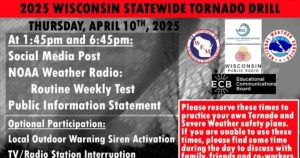Tornado Safety Before the Storm
Develop a plan for you and your family for home, work, school and outdoors. Know the safest shelter areas in multiple locations.
- Have frequent drills.
- Keep a disaster supply kit in your home including water, food that won’t spoil and needs no heat to serve, first-aid kit, NOAA Weather Radio (also known as an emergency weather radio), a flashlight and special items for children, pets and elderly family members.
- Be sure your weather radio is working properly. Spring is a great time to install fresh batteries.
Tornado Safety During the Storm
Whether at home, work, or school, it’s important to have a plan in place for what to when severe weather is approaching.
- In a home or building, move to a pre-designated shelter, such as a basement, and get under a sturdy table or the stairs. A specially-constructed “safe room” within a building offers the best protection.
- If a basement is not available, move to a small interior room on the lowest floor and cover yourself with anything close at hand: towels, blankets, pillows. If possible, get under a sturdy table, desk or counter. Put as many walls as possible between you and the storm. Stay away from windows.
- If caught outdoors, seek shelter in a sturdy building. If you cannot quickly walk to shelter, get into a vehicle, buckle your seatbelt and drive to the closest sturdy shelter. If flying debris occurs while you are driving, pull over and park. Now you have two options as a last resort:
- Stay in the vehicle with the seatbelt on and place your head below the windows.
- If you can safely get noticeably lower than the roadway, exit the vehicle and lie in that area, covering your head with your hands. Do not seek shelter under an overpass.
- Mobile homes, even if tied down, offer little protection from tornadoes. You should leave a mobile home and go to the designated storm shelter or the lowest floor of a sturdy nearby building.
- Make sure you have multiple ways to receive weather information. A NOAA Weather Radio, access to local TV, and smart phone apps can keep you informed when severe weather threatens.
Lightning Safety Tips
Lightning can be a major safety concern during storms. Know the risks and how to protect yourself from lightning strikes.
- All thunderstorms produce lightning and are dangerous. In an average year, lightning kills nearly 50 people in the U.S. Since 2005, lightning has killed nine people and injured at least 41 in Wisconsin.
- Lightning often strikes outside the area of heavy rain and may strike as far as 10 miles from any rainfall.
- If you hear thunder, you are in danger! Anytime thunder is heard, the storm is close enough to pose an immediate threat to your location.
- Have a lightning safety plan. Designate a safe location before the event
- starts. Have specific guidelines for suspending the activity so that everyone has time to reach safety.
- Prior to a practice or outdoor event, check the latest forecast. If thunderstorms are expected, consider postponing activities early to avoid being caught in a dangerous situation.
- If you hear thunder, suspend your activity immediately and instruct everyone to get to a safe place. Substantial buildings provide the best protection. Avoid sheds, open shelters, dugouts, bleachers, and grandstands. If a sturdy building is not nearby, a hard-topped metal vehicle with windows closed will offer good protection. Do not crouch or lie down—continue moving to a place of shelter.
- If boating or swimming, get to land and find shelter.
- Do not resume activities until 30 minutes have passed since the last thunder was heard.
Stay informed with an All Hazards NOAA Weather Radio
Many people believe outdoor sirens will notify them when a tornado is approaching, however those devices are only designed to be heard by people who are outside. Make sure you have a way to receive notifications inside your home, school or office by getting a NOAA Weather Radio. These devices act like a “smoke alarm” for severe weather!
- NOAA Weather Radio (NWR) is a public warning system that broadcasts forecasts, warnings, and emergency information 24 hours a day.
- Radio receivers can quietly monitor these broadcasts and will alert when important and life-threatening messages are issued for your area.
- “All Hazards” messages include:
- Natural disasters (e.g., tornado, floods, blizzards)
- Accidents, such as chemical release, train derailments, nuclear power emergencies)
- Terrorist Attacks
- During an emergency, seconds count! These radios are a valuable alerting device, easy to use, and can also be used to check on every-day weather, including wind chill information during the winter. If your school doesn’t have a weather radio, make sure to purchase one before the severe weather season starts.
- Place your radio in areas that are constantly monitored (e.g., school office, principal’s office). Remember those occasions when the school is used for activities outside normal hours and make sure the radio can be monitored during those times.
- The radios are tested weekly. Make sure yours works!
- If you have any questions about weather radios, contact your local National Weather Service office. Many Wisconsin offices may have radios available for schools.




